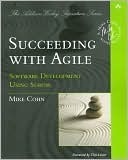More on this book
Kindle Notes & Highlights
by
Mike Cohn
That being said, an improvement community does not exist to serve the ETC. It exists to serve its customers: the Scrum development teams who are building products or systems.
Although an ETC member will act as product owner for some improvement communities and will serve as the official product owner for the sprint reviews, you should expect members of interested development teams to be active participants as well.
• Add to your improvement backlog by looking at the section headings of the chapters in this book. Many of them were written with this possibility specifically in mind. • Review any notes available from recent sprint retrospectives. These are often an excellent source of improvement backlog items.
For an improvement community to have the most impact, its members must focus on goals of immediate and practical relevance to the development teams using or attempting to get started with Scrum.
The best way to do this is for improvement community members to work side by side with development team members on something important to the development team. This is what Google’s “test mercenaries” do. Test mercenaries are members of the testing community who are experienced engineers with a passion for and expertise in testing. They spend up to 20% of their time for three months on a project other than their own. During this time they add tests and refactor code as a direct help to the development team.
I suppose that test mercenaries could instead spend this time creating presentations and spreading the gospel of developer testing. Something tells me, though, they are better able to achieve their goals by working with a team rather than preaching to it. A development team that has had the help of a test mercenary ends up with improved code and more tests. It also witnesses the benefits of an additional focus on developer testing. This works wonders ...
This highlight has been truncated due to consecutive passage length restrictions.
change should be done “with, not to, the people expected to change” (2000b).
A participant’s manager, product owner, and ScrumMaster, though, are responsible for ensuring that those passionate enough about a change to work toward it are given sufficient time to do so. Google accomplishes this by telling each employee to spend 20% of each week on something of interest. The time could be spent, for example, exploring a new product idea or participating in a community.
Google’s 20% policy and Salesforce.com’s PTON programs were not created specifically to allow people to work in an improvement community. And organizations do not need to make such dramatic changes just to get started adopting Scrum. An easy starting point is simply for managers to commit to freeing up some number of hours each week for those who want to work on an improvement community.
“What could we improve?” and “What are we doing well that others should know about?”
Improvement communities are ad hoc and organic, formed whenever passion for a topic brings people together. SEPGs are formally created and often discouraged from functioning in an ad hoc manner.
Identify an improvement you are passionate about. Ask two or three coworkers to help you. Create an improvement backlog and plan a first sprint. Even if you can manage only an hour a week on it, start. As you begin to make progress, incorporate your improvement in the work of your team or offer it to another team. Generate interest by telling (or, even better, showing) others what you’ve accomplished.
important it creates an environment that encourages other communities to form.
These communities—called improvement communities—are formed when a group of employees choose to work together to improve the organization’s use of Scrum. Both types of communitites use Scrum to drive the organization toward becoming agile.
Katzenbach, Jon. R. 1997. Real change leaders: How you can create growth and high performance at your company. Three Rivers Press. Katzenbach’s book is based on extensive interviews with individuals who he found to be the true source of change in organizations. These are the “real change leaders” of the book’s title. The book contains many engaging stories about individuals who would make good improvement community members.
Kotter, John P. 1996. Leading change. Harvard Business School Press. Kotter’s highly respected book is a classic on organizational change. In it, he lays out an eight-step process for creating change. In his second step, Kotter advocates the creation of a guiding coalition, which has some similarities to an ETC. Additionally, his article in Harvard Business Review (1995) offers a concise summary of this book.
Wenger, Etienne, Richard McDermott, and William M. Snyder. 2002. Cultivating communities of practice. Harvard Business School Press.
Wenger is recognized as the authority on communities of practice. This highly readable book describes
everything you need to know to begin cultivating communities within your organization, including a chapter dedicated to...
This highlight has been truncated due to consecutive passage length restrictions.
Woodward, E. V., R. Bowers, V. Thio, K. Johnson, M. Srihari, and C. J. Bracht. Forthcoming. Agile methods for software practice transformation. IBM Journal of Research and Development 54 (2). Members of IBM’s Quality Software Engineering organization are using an approach very similar to the one described in this chapter to spread agile throughout IBM. This excellent paper describes how they function as an Enterprise Transition Community, ways in which they enc...
This highlight has been truncated due to consecutive passage length restrictions.


